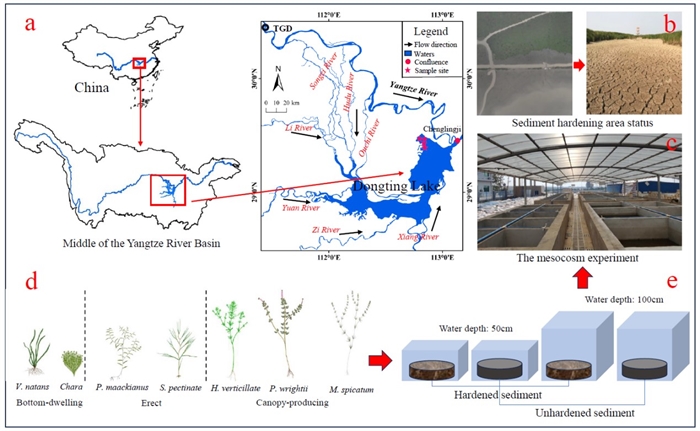Sediment Hardening Effect Obviously on Submerged Plants in Dongting Lake Area
Submerged plants, as primary producers in lake ecosystems, play an essential role in maintaining ecological stability. During last 15 years, submerged vegetation in Dongting Lake has experienced significant degradation, with some areas witnessing complete disappearance. This degradation poses a serious threat to the ecological health of the lake region. Since the operation of the Three Gorges Dam, the hydrological conditions in Dongting Lake have undergone dramatic changes, including prolonged dry seasons and earlier water recession periods. These changes have extended the exposure of previously submerged lakebeds, resulting in widespread sediment hardening during the dry season.
A research team led by Professor Xie Yonghong from the Institute of Subtropical Agriculture, Chinese Academy of Sciences, conducted field investigations and controlled experiments to analyze the characteristics of sediment hardening and its impacts on the growth of submerged plants. At the time, they explored various sediment remediation measures to promote the growth of submerged vegetation. Their new findings were recently published in Plant and soil and Frontiers in Plant Science.
It revealed significant changes in soil characteristics within the 0–10 cm sediment layer after hardening. For instance, the proportion of large sediment aggregates significantly increased in compacted sediments, while soil total nitrogen (TN), total phosphorus (TP), and soil organic carbon (SOC) content also rose. In contrast, soil pH decreased.
Furthermore, bacterial and fungal richness in hardened sediments was significantly higher than in unhardened sediments. The structure of fungal communities was primarily influenced by the degree of hardening, whereas bacterial community structure was mainly affected by vertical depth.
Additionally, they found that sediment hardening hindered the colonization and community establishment of submerged plants. For example, it reduced plant biomass, decreased maximum root length, and increased average root diameter. The combined effects of sediment hardening and water levels also resulted in overall root system shortening. The effectiveness of sediment remediation measures in promoting plant growth varied. On the one hand, loosening the hardened sediment alone increased plant biomass and encouraged root development. On the other hand, a combined treatment of sediment loosening and litter addition exhibited specific responses depending on the growth form of the submerged plants.
The findings emphasize the potential interactive effects of sediment hardening and water levels in regulating the growth and development of submerged vegetation in river-connected lakes. "Tailored sediment remediation measures based on the growth type of submerged plants can help achieve optimal restoration outcomes," said Professor Xie Yonghong, the corresponding author of the paper. "These findings provide crucial guidance for the future restoration of submerged vegetation in Dongting Lake."
Contact: Chuanxin Chao; Yonghong Xie
E-mail: chaochuanxin94@163.com; yonghongxie@163.com
DOI:10.3389fpls.2024.1450404 (Frontiers in Plant Science)

Sediment hardening in Dongting Lake and controlled experimental platform. (Image by Chao Chuanxin)
Download attachments: